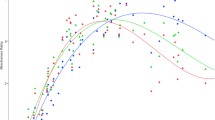Abstract
This article examines the potential health effects of television. A survey of 1035 Flemish 17- and 18-year-olds shows that eating snacks and drinking regularly accompany viewing. Television was also shown to influence sleeping and family meals. Heavy viewers did not, however, appear to be more passive than lighter viewers. Their indulgence in sports did not differ, but content-specific relationships with going out appear to exist. In this group no link between viewing and obesity was found, but viewing was significantly related to various aspects of people's self assessments regarding their weight, their ideal weight and their looks. Particular attention was given to those television programs that portray “idealized bodies.” Generally, a distinction was made between men and women because many body-, weight-, and health-related factors may be culture and gender specific.
Similar content being viewed by others
REFERENCES
Brown, J. D., and Walsh-Childers, K. (1994). Effects of media on personal and public health. In Bryant, J., and Zillmann, D. (eds.), Media Effects, Advances in Theory and Research. Lawrence Erlbaum, Hillsdale, NJ, pp. 389–415.
Cassata, M. B., Skill, T. D., and Osei Boadu, S. (1979). In sickness and in health. J. Commun. 29(4): 73–80.
Cassata, M., Skill, T., and Osei Boadu, S. (1983). Life and death in the daytime television serial: A content analysis. In Cassata, M., and Skill, T. (eds.), Life on Daytime Television: Tuning in American Serial Drama, Ablex, Norwood, pp. 47–70.
Dietz, W. H. (1990). You are what you eat—what you eat is what you are. J. Adolesc. Health Care (11): 76–81.
Dietz, W. H., and Gortmaker, S. L. (1985). Do we fatten our children at the television set? Obesity and television viewing in children and adolescents. Pediatrics 75(5): 807–812.
Feldman, W., Feldman, E., and Goodman, J. T. (1988). Culture versus biology: Children's attitudes towards thinness and fitness. Pediatrics 81: 190–194.
Gerbner, G., Morgan, M., and Signorielli, N. (1982). Programming health portrayals: What viewers see, say, and do. In Pearl, D., and Lazar, J. (eds.), Television and Behavior: Ten Years of Scientific Progress and Implications for the Eighties (Vol. 2, Ed.). U.S. Government Printing Office, Washington, pp. 291–307.
Harrison, K. (1997). Does interpersonal attraction to thin media personalities promote eating disorders? J. Broadcasting and Electronic Media 41: 478–500.
Harrison, K., and Cantor, J. (1997). The relationship between media consumption and eating disorders. J. Commun. 47(1): 40–67.
Kaufman, L. (1980). Prime time nutrition. J. Commun. 30(3): 37–46.
Kubey, R. W. (1984). Television use in everyday life: Coping with unstructured time. J. Commun. 36: 108–123.
McQuail, D., Blumler, J., and Brown, J. (1972). The television audience: A revised perspective. In McQuail, D. (ed.), Sociol. Mass Commun. Penguin, Harmondsworth, pp. 135–165.
Mechanic, D., and Hansell, S. (1987). Adolescent competence, psychological well-being, and selfassessed physical health. J. Health Soc. Behav. 28: 364–374.
Myers, P. N., and Biocca, F. A. (1992). The elastic body image: The effect of television advertising and programming on body image distortions in young women. J. Commun. 42(3): 108–133.
Rauste-von Wright, M. (1989). Body image satisfaction in adolescent girls and boys: A longitudinal study. J. Youth Adolesc. 18(1): 71–83.
Rosengren, K. E., and Windahl, S. (1989). Media Matter: TV Use in Childhood and Adolescence. Ablex, Norwood.
Roloff, M. E., and Berger, Ch. R. (1982). Social cognition and communication: An introduction. In Roloff, M. E., and Berger, Ch. R. (eds.), Social Cognition and Communication. Beverly Hills, Sage, pp. 9–32.
Rosenthal, R. (1986). Media violence, antisocial behavior and the social consequences of small effects. Media Violence, Antisoc. Behav. Soc. Conseq. Small Effects 42(3): 141–154.
Signorielli, N. (1993). Mass Media Images and Impact on Health: A Sourcebook. Greenwood Press, Westport.
Sumner, A., Waller, G., Killick, S., and Elstein, M. (1993). Body image distortion in pregnancy: A pilot study of the effects of media images. J. Reprod. Infant Psychol. 11(4): 203–208.
Tan, A. S. (1977). TV beauty ads and role expectations of adolescent female viewers. Journalism Quarterly 56(2): 283–288.
Tucker, L. (1986). The relationship of television viewing to physical fitness and obesity. Adolescence 21(84): 797–806.
Wober, M., and Gunter, B. (1985). Television and beliefs about health care and medical treatment. Curr. Psychol. Res. Rev. (Winter), 291–304.
Wober, M., and Gunter, B. (1988). Television and Social Control. Avebury, Aldershot.
Author information
Authors and Affiliations
Additional information
Fund for Scientific Research (Flanders)
Rights and permissions
About this article
Cite this article
Van den Bulck, J. Is Television Bad for Your Health? Behavior and Body Image of the Adolescent “Couch Potato”. Journal of Youth and Adolescence 29, 273–288 (2000). https://doi.org/10.1023/A:1005102523848
Issue Date:
DOI: https://doi.org/10.1023/A:1005102523848




